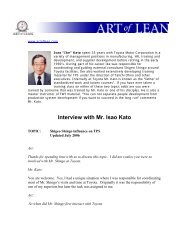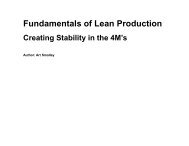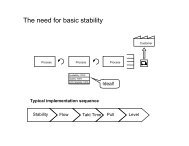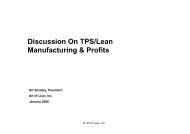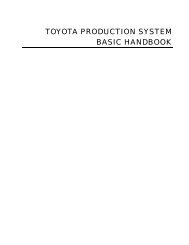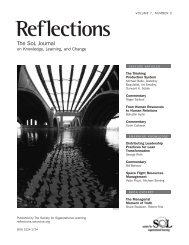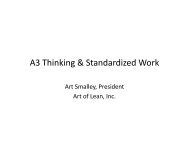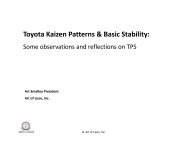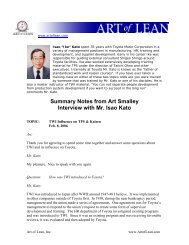Kamigo Engine Plant Tour Review Toyota Motor ... - Art of Lean
Kamigo Engine Plant Tour Review Toyota Motor ... - Art of Lean
Kamigo Engine Plant Tour Review Toyota Motor ... - Art of Lean
Create successful ePaper yourself
Turn your PDF publications into a flip-book with our unique Google optimized e-Paper software.
<strong>Kamigo</strong> <strong>Engine</strong> <strong>Plant</strong> <strong>Tour</strong> <strong>Review</strong><br />
<strong>Toyota</strong> <strong>Motor</strong> Corporation needs no introduction. The company is the second leading<br />
producer <strong>of</strong> automotive vehicles in the world and is rapidly closing in on number one<br />
General <strong>Motor</strong>s. In addition <strong>Toyota</strong> is a regular recipient <strong>of</strong> quality awards and is always<br />
near the top <strong>of</strong> the Harbour Report’s productivity rankings. <strong>Toyota</strong> has earned over $10-<br />
12 billion in pr<strong>of</strong>its each <strong>of</strong> the last two years while major competitors have lost several<br />
billion over the same period. Indeed <strong>Toyota</strong> has not reported a net loss in income since<br />
the early 1950’s.<br />
One <strong>of</strong> the most famous plants in the company is <strong>Kamigo</strong> <strong>Engine</strong> <strong>Plant</strong> located on the<br />
outskirts <strong>of</strong> <strong>Toyota</strong> City, Japan. The facility was established as the first dedicated engine<br />
plant in the company in 1965 and Taiichi Ohno was the founding plant manager. The<br />
plant was considered the “model” facility for <strong>Toyota</strong>’s production system with respect to<br />
the pillars <strong>of</strong> Just in Time production as well as the more difficult concept <strong>of</strong> Jidoka.
Many <strong>of</strong> Mr. Ohno’s early disciples are from either this engine plant or the original<br />
Honsha plant machine shops.<br />
I formerly worked at this facility in Administration, Maintenance, and Manufacturing<br />
<strong>Engine</strong>ering quite some time ago. This fall I was able to return and visit the facility for<br />
the fist time in several years for an extended tour and discussion with senior managers.<br />
The following is a summary <strong>of</strong> some the different discussion points over the two separate<br />
visits. The names <strong>of</strong> the individuals are kept anonymous based upon requests that I will<br />
<strong>of</strong> course honor.<br />
<strong>Art</strong>:<br />
<strong>Toyota</strong> seems to really hitting on all cylinders these days?<br />
Appearances are usually deceiving. If you are talking about pr<strong>of</strong>its yes they are indeed at<br />
an all time high as is production volume but it has put a real strain on the system in terms<br />
<strong>of</strong> keeping up. It feels like we are running flat out in many respects.<br />
<strong>Art</strong>:<br />
So what is behind all these pr<strong>of</strong>its?<br />
We have both a very favorable sales mix and overall sales trend working in our favor<br />
right now especially in the United States. Over half our pr<strong>of</strong>its come from this one<br />
market. The higher margin vehicles are selling really well. In North American alone we<br />
are adding the equivalent <strong>of</strong> a whole new facility per year to keep up with the volume<br />
growth.<br />
<strong>Art</strong>:<br />
What has changed the most since I worked here?<br />
So many things have changed I am not even sure where to begin. First the 10 engine<br />
lines here have almost all changed. The old S family engine machining lines are all gone.<br />
RZ/TZ line you worked on last is still here but is now our oldest in the facility. The<br />
other lines are all new aluminum block and head models as well. The casting shop no<br />
longer produces cast iron blocks it has been converted to all aluminum die casting. It is<br />
much cleaner and nicer how. The old press department is gone as well.<br />
<strong>Art</strong>:<br />
No deep details needed but what is the overall volume and number <strong>of</strong> employees now?
We produce over 10,000 engines per day <strong>of</strong>f ten different machining and assembly lines.<br />
At last count there were almost 4,000 employees in the facility.<br />
<strong>Art</strong>:<br />
That is a big change in capital structure, volume, and personnel!<br />
That is only the tip <strong>of</strong> the iceberg. The labor structure has changed entirely in Japan since<br />
you left. Back then we had veteran employees with 15-20 years experience on average in<br />
production. Today we have around 40% temporary employees on six month contracts.<br />
Most are very young in their early to mid 20’s and half <strong>of</strong> these are female. By law in<br />
Japan we are required to achieve “labor equality” in terms <strong>of</strong> ratio so the number <strong>of</strong><br />
female workers will continue to increase and become part <strong>of</strong> the permanent labor pool.<br />
<strong>Art</strong>:<br />
That is a big change. Temporary workers were at most 5-10% when I was here and the<br />
first two female production employees had been hired an put on the RZ/TZ engine line<br />
in my old area. What has been the effect <strong>of</strong> all this change?<br />
There has been only positive effects with the addition <strong>of</strong> the female population to the<br />
workforce in all honesty. That has been a real positive as far as management is<br />
concerned in every respect and forced us to adapt and improve in many ways that we<br />
should have long ago. The real challenge has been simply the high number <strong>of</strong> temporary<br />
workers and the turn over in the work force. The younger population is more likely to<br />
work for 12-18 months and them move on or take an extended period <strong>of</strong> rest. This has<br />
put a real strain on <strong>Toyota</strong> and even more on the supply base. The suppliers are having to<br />
import foreign workers on temporary work visas in many cases due to the labor shortage<br />
here in Aichi Prefecture.<br />
<strong>Art</strong>:<br />
I see that <strong>Toyota</strong> is taking quite a hit in terms <strong>of</strong> quality lately. Is this all related?<br />
I assume you are referring to the increase in warranty claims and recall incidents. The<br />
causes <strong>of</strong> these problems are split evenly among production, product design, and supplier<br />
defects. There have been incidents in production <strong>of</strong> errors that trace back to newer<br />
employees and we are taking steps to simplify processes even further and prevent defects<br />
from occurring and escaping. I suppose the same is true in the case <strong>of</strong> product<br />
development and the supplier errors. Everyone is acknowledging this fact right now and<br />
working long hours to correct the problems as best possible.
<strong>Art</strong>:<br />
I toured the AZ engine line at the far end <strong>of</strong> the plant. It seemed in excellent shape?<br />
Yes it is operating at 5 ppm <strong>of</strong> defects <strong>of</strong>f the engine final test line. Most components in<br />
machining are in the .2% scrap level in terms <strong>of</strong> pieces produced. The problems have<br />
been more in assembly in many cases. Many product development related problems are<br />
things like bracket failure on doors etc. that were not sufficiently tested or analyzed in<br />
product development. They are small but inexcusable mistakes and they will not be<br />
repeated if everyone does their follow up work correctly.<br />
<strong>Art</strong>:<br />
That is the most amazing thing to me about <strong>Toyota</strong> after all these years. It is not that the<br />
company is perfect it is that emphasis is on learning from failure and the emphasis on<br />
recurrence prevention is so high.<br />
We are so far from perfect that it is laughable to even put that word in the same sentence<br />
with our company. They key in management is still to focus on your abnormal cases and<br />
problems and eliminate the true root causes for these items. That is the only way to really<br />
improve in the long run.<br />
<strong>Art</strong>:<br />
So what is the DNA <strong>of</strong> <strong>Toyota</strong> in your opinion and the reason why are you still so<br />
successful?<br />
Once you strip away all the fancy buzzwords surrounding the company it is simply<br />
rigorous problems solving or kaizen depending upon which side <strong>of</strong> the performance line<br />
you are on. If you are underachieving you have a deviation from standard or a problem<br />
by definition. If you are at standard then the bar is raised and you must improve using<br />
some creative methods to accomplish kaizen. The endless cycle <strong>of</strong> PDCA for<br />
improvement is the only constant along with the pressure to perform.<br />
<strong>Art</strong>:<br />
What have you worked on improving the most lately?<br />
It has been a lot <strong>of</strong> back to the basics. Proper job instruction for new workers and<br />
teaching them properly from day one. “Mieru-ka” is a movement lately meaning to make<br />
things more visible. We have a lot <strong>of</strong> safety covers and things obstructing views <strong>of</strong> the<br />
production process in our environment. So you can not see into the process at all in many
cases. We’ve been working on ways to remove the covers and make the process both<br />
more visible and safe at the same time. The reason is that in machining operations we<br />
want the production operators to see the cutting chips and coolant flow more clearly and<br />
understand the process better. In general just more emphasis on problem solving related<br />
to scrap and rework. Ownership <strong>of</strong> daily maintenance items related to cleaning,<br />
lubrication, and simple checks by production is always a priority as well.<br />
<strong>Art</strong>:<br />
It is kind <strong>of</strong> strange for me as a former employee but did you know that the prevailing<br />
notion in the U.S. is that you are aligned in value streams with a single manager from<br />
end to end running the whole flow <strong>of</strong> materials and you draw material and information<br />
flow maps to make improvements. Can you comment on this?<br />
I believe that is an American created term or made up by some other people. We<br />
continue to have departmental managers in production and work in a sort <strong>of</strong> matrix style<br />
organization. No one manages production from raw materials all the way to the end <strong>of</strong><br />
the vehicle plant for example. That does not even happen in the engine plant. There are<br />
managers for casting, machining and assembly here. Machine shop managers have a<br />
department and manage a machine shop with many component lines within it such as<br />
cam shaft, crank shaft, cylinder block, cylinder head, piston, etc. The vehicle plant has<br />
managers for stamping, body welding, paint, plastics, and final assembly. This practice<br />
has not changed at all since you worked here.<br />
The Value Stream Mapping tool you refer too is an analysis technique not widely used<br />
here in machine shops. Actually very few people in the company use it. I have never<br />
drawn one. Someone might use one to measure the lead time from casting, through<br />
machining, to vehicle assembly or to count inventory. There might be one or two in this<br />
entire plant <strong>of</strong> 4,000 people but maybe none. Is just a spot analysis technique and<br />
nothing more for us.<br />
<strong>Art</strong>:<br />
This brings up a good question. What improvement tools are mostly used in a <strong>Toyota</strong><br />
engine plant?<br />
Rigorous thinking and problem solving. You can’t get anything done without this<br />
capability. On the engine assembly lines improvement requires the ability to conduct<br />
time studies, motion analysis, material flow analysis and other simple kaizen techniques<br />
to raise productivity. Fixing quality problems requires the ability to thoroughly execute<br />
the PDCA cycle and the structured steps <strong>of</strong> problem solving.<br />
Improvements in machining are more technical and can’t be solved with just industrial<br />
engineering type techniques or simple flow mapping. The value add is performed by the
cutting tool removing metal in machining so you need to learn more about the machines,<br />
materials, tooling, and the mechanical properties <strong>of</strong> chip removal.<br />
<strong>Art</strong>:<br />
So how are you training people to make improvements in machining areas?<br />
It is still the same way that you had to learn via OJT. There is no easy shortcut for this<br />
area. In some cases like yours we have people initially work in the spare parts machine<br />
shop to learn the basics <strong>of</strong> turning, milling, and grinding for example.<br />
Then they are assigned some basic quality and downtime problems to be solved in detail.<br />
No value stream mapping is used but they have to learn the 30 processes that make up the<br />
crankshaft line for example one by one. We have people sketch the machining process,<br />
identify the datum point, study the clamp mechanism, learn the type <strong>of</strong> cutting tool, and<br />
how the chip is removed for example. It is lot <strong>of</strong> attention to detail and it requires<br />
“getting your hands dirty” as the old saying goes.<br />
There is lots <strong>of</strong> technical documentation involved and process capability issues as well.<br />
We still think it takes 5-7 years to make a young engineer learn all the basic aspects <strong>of</strong><br />
the job in machining and become pr<strong>of</strong>icient in kaizen.<br />
<strong>Art</strong>:<br />
What key points <strong>of</strong> advice for anyone wanting to improve using TPS style activities in this<br />
sort <strong>of</strong> environment?<br />
Number one it is a lot <strong>of</strong> hard work so don’t kid yourself into thinking otherwise. Mr.<br />
Ohno started TPS in the machine shops <strong>of</strong> <strong>Toyota</strong> and this is where the real TPS pillars <strong>of</strong><br />
JIT and Jidoka concepts come from. It did not happen over night and it was a long battle<br />
that involved improvements in processes, tooling, maintenance, etc. for example.<br />
Second don’t confuse the “objective” versus the “method”. I keep seeing or reading<br />
these comments about flow, standardized work, pull, or visual control etc. being the<br />
“goal” <strong>of</strong> different companies production system or improvement efforts. Those items<br />
are merely techniques and they will get you no where in the long run if you only focus on<br />
applying them. The real objective in TPS is to obtain a pr<strong>of</strong>it and satisfy the customer.<br />
In manufacturing our small role is to build in the highest possible quality, reduce cost,<br />
and deliver in the shortest time possible. Everything else under that is just a method<br />
whether it be kanban, or standardized work, or level production for example. The<br />
methods and tools will change over time. Don’t waste time copying <strong>Toyota</strong>’s tools.<br />
Figure out what your own biggest problems are and solve those.<br />
Third the real emphasis in machine intensive shops is building in quality and separation<br />
<strong>of</strong> man from machine. Jidoka is equal if not more important that JIT in machining. You<br />
can fix the flow fairly easily if you have great processes. If you just have JIT and poor
processes then you are in trouble. For some reason Americans and proponents <strong>of</strong> <strong>Lean</strong><br />
overseas that I hear about only seem to like JIT activities. I guess that is easier to<br />
understand.<br />
In the end though it is all about people development. In production we need cross<br />
function workers able to run all thirty <strong>of</strong> the processes on the crankshaft line who are also<br />
skilled in simple maintenance, tooling, and gauging techniques. The engineering and<br />
management staff has to be developed to support different areas over time as well. In<br />
both cases we need to develop people who can think and lead. I the end human resources<br />
are all we really have as a company so we must focus on developing this critical resource.<br />
Thank you for your time and cooperation.



